Study on Reservoir Characteristics, the Tightening Process and Reservoir Quality in Source-to-Sink Systems in the Xu-2 Member of the Xujiahe Formation in the Western Sichuan Basin, Western China
Abstract
1. Introduction
2. Geologic Background
2.1. Structural Setting
2.2. Stratigraphy and Sedimentary Facies
3. Data and Methods
4. Results
4.1. Lithology Characteristics of the Xu-2 Member in the Western Sichuan Basin
4.2. Reservoir Properties of the Xu-2 Member in the Western Sichuan Basin
4.3. Diagenetic Minerals of the Xu-2 Member in the Western Sichuan Basin
4.3.1. Carbonates
4.3.2. Quartz
4.3.3. Clay Minerals
4.4. Compaction of the Xu-2 Member in the Western Sichuan Basin
4.5. Dissolution of Framework Grains of the Xu-2 Member in the Western Sichuan Basin
4.6. Fractures of the Xu-2 Member in the Western Sichuan Basin
5. Discussion
5.1. Diagenetic Evolution Sequence
5.2. Quantitative Characterization of Pore Evolution
5.2.1. Initial Porosity
5.2.2. Porosity After Compaction
5.2.3. Reduced Porosity Due to Cementation
5.2.4. Increased Porosity Due to Dissolution
5.3. Mechanism of Reservoir Tightening
5.3.1. Quartz-Rich Sandstone
5.3.2. Feldspar-Rich Sandstone
5.3.3. Rock-Fragment-Rich Sandstone
5.4. Source-to-Sink System and Reservoir Quality
5.4.1. Lithology Characteristics in Different Source-to-Sink Systems
5.4.2. Reservoir Properties in Different Source-to-Sink Systems
5.4.3. Reservoir Quality and Its Controlling Factor in Different Source-to-Sink Systems
6. Conclusions
- The clastic components of the tight sandstones of the Xu-2 Member in the western Sichuan Basin include quartz, rock fragment, and feldspar. Rock fragments constitute the main detrital minerals. The tight sandstones are composed of litharenite, sublitharenite, and feldspathic litharenite. Litharenites are commonly observed. The porosity of the Xu-2 sandstone mainly ranges from 1.0% to 5.0% and the permeability mainly ranges from 0.01 to 0.5 mD.
- The diagenetic minerals of the Xu-2 sandstone are mainly carbonates, quartz, and clay minerals. The basal calcites formed in the early precipitation time extensively fill the primary intergranular pores and early dissolution pores. Another type of calcite, a small amount of dolomite, and Fe-dolomite mainly precipitate after feldspar dissolution events and fill the secondary dissolution pores of feldspar. The quartz overgrowths are more common with more detrital quartz and less carbonate cement. Autogenic quartz generally fills intergranular or intragranular dissolution pores. The chlorite is the main clay mineral and is distributed with a relatively high content of rock fragments. The precipitation of most chlorite occurs during the early diagenetic stage. As a result, the chlorite effectively preserves primary intergranular pores.
- The compaction is strong in the deeply buried tight sandstones of the Xu-2 Member, resulting in a decrease in porosity. The dissolution of framework grains enhances the porosity. The relative timing of the diagenetic events was concluded in at least five stages, namely the initial mechanical compaction stage, the feldspar leaching and early quartz cementing stage, the quartz overgrowths dissolution and early carbonate cementing stage, the carbonate cement dissolution stage, and the late carbonate cementing stage. The initial porosity, porosity after compaction, reduced porosity due to cementation and increased porosity due to dissolution in the diagenetic evolution sequence were calculated.
- The Xu-2 sandstones were further subdivided into the quartz-rich, rock-fragment-rich and feldspar-rich sandstones. In the quartz-rich sandstone, the compaction and pressure solution were the primary causes of reservoir tightening, while late fracturing and dissolution along fractures were the main factors improving reservoir properties. In the feldspar-rich sandstone, early dissolution was a primary factor in improving porosity, while carbonate and quartz cements generated by dissolution contributed to a decrease in porosity. In the rock-fragment-rich sandstone, chlorites formed in the early stage and dissolution were the main factors in reservoir quality improvement, while the authigenic quartz formed in the middle diagenetic stage was the primary cause of reservoir tightening.
- Four major source-to-sink systems were identified. The Zitong source-to-sink system is relatively close to the provenance, and dissolution in the early and middle diagenetic stages of feldspar-rich sandstones and rock-fragment-rich sandstones improved reservoir quality. In the Xinchang source-to-sink system, the chlorite, quartz, and coarse grains have a strong impact on reservoir quality by preserving primary intergranular pores. In the Yazihe–Chengdu source-to-sink system, the dissolution is common and the reservoir is strongly influenced by secondary pores related to feldspar. In the Dayi source-to-sink system, factors resisting compaction such as quartz and coarse grains have an impact on reservoir quality, and the fractures caused by compaction improve the permeability.
Author Contributions
Funding
Data Availability Statement
Acknowledgments
Conflicts of Interest
Abbreviations
| SEM | Scanning electron microscopy |
| EDS | Energy dispersive spectrometer |
| Φ1 | Initial porosity |
| Φ2 | Porosity after compaction |
| Φp | Porosity of rock sample |
| Φtp | Porosity of thin section |
| Φti | Intergranular porosity of thin section |
| Φtd | Dissolution porosity of cements of thin section |
| Φc | Cement content |
| S0 | Trask sorting coefficient |
| Q1 | Larger quartile of particle |
| Q3 | Smaller quartile of particle |
| C | Compaction factor |
| Z | Depth |
| Q | Quartz |
| RF | Rock fragments |
| F | Feldspar |
| P | Pores |
| SRF | Sedimentary rock debris |
| MRF | Metamorphic rock debris |
| VRF | Volcanic rock debris |
| Cal | Calcites |
| AQ | Autogenic quartz |
| QO | Quartz overgrowths |
| IL | Illite |
| Fe-Dol | Fe-dolomites |
| Ch | Chlorites |
| Mi | Mica |
| Fr | Fractures |
| T3 | Late Triassic |
| J1 | Early Jurassic |
| J2 | Middle Jurassic |
| J3 | Late Jurassic |
| K | Cretaceous |
| E | Paleogene |
References
- Zou, C.N.; Zhu, R.K.; Wu, S.T.; Yang, Z.; Tao, S.Z.; Yuan, X.J.; Hou, L.H.; Yang, H.; Xu, C.C.; Li, D.H.; et al. Types, characteristics, genesis and prospects of conventional and unconventional hydrocarbon accumulations: Taking tight oil and tight gas in China as an instance. Acta Pet. Sin. 2012, 33, 173–187, (In Chinese with English Abstract). [Google Scholar]
- Churchill, S.A.; Inekwe, J.; Smyth, R.; Zhang, X. R&D intensity and carbon emissions in the G7: 1870–2014. Energy Econ. 2019, 80, 30–37. [Google Scholar]
- Zhong, Z.Q.; Chen, Y.Q.; Fu, M.Y.; Li, M.Z.; Yang, K.S.; Zeng, L.P.; Liang, J.; Ma, R.P.; Xie, Q. Role of CO2 geological storage in China’s pledge to carbon peak by 2030 and carbon neutrality by 2060. Energy 2023, 272, 127165. [Google Scholar] [CrossRef]
- Fic, J.; Pedersen, P.K. Reservoir characterization of a “tight” oil reservoir, the middle Jurassic Upper Shaunavon Member in the Whitemud and Eastbrook pools, SW Saskatchewan. Mar. Pet. Geol. 2013, 44, 41–59. [Google Scholar] [CrossRef]
- Stroker, T.M.; Harris, N.B.; Elliott, W.C.; Wampler, J.M. Diagenesis of a tight gas sand reservoir: Upper Cretaceous Mesaverde Group, Piceance Basin, Colorado. Mar. Pet. Geol. 2013, 40, 48–68. [Google Scholar] [CrossRef]
- Wu, D.; Li, H.; Jiang, L.; Hu, S.; Wang, Y.; Zhang, Y.; Liu, Y. Diagenesis and reservoir quality in tight gas bearing sandstones of a tidally influenced fan delta deposit: The Oligocene Zhuhai Formation, western Pearl River Mouth Basin, South China Sea. Mar. Pet. Geol. 2019, 107, 278–300. [Google Scholar] [CrossRef]
- Jia, C.Z.; Zou, C.N.; Li, J.Z.; Li, D.H.; Zheng, M. Assessment criteria, main types, basic features and resource prospects of the tight oil in China. Acta Pet. Sin. 2012, 33, 343–350, (In Chinese with English Abstract). [Google Scholar]
- Meng, Y.; Wang, Z.; Zhang, F.; Meng, F.; Jiao, J.; Shi, L. Characteristics and forming mechanism of tight sandstones in the Paleogene Shahejie Formation of southern West Sag, Liaohe Depression. J. Palaeogeogr. 2016, 18, 569–580, (In Chinese with English Abstract). [Google Scholar]
- Lai, J.; Wang, G.W.; Wang, S.; Cao, J.T.; Li, M.; Pang, X.J.; Zhou, Z.L.; Fan, X.Q.; Dai, Q.Q.; Yang, L.; et al. Review of diagenetic facies in tight sandstones: Diagenesis, diagenetic minerals, and prediction via well logs. Earth-Sci. Rev. 2018, 185, 234–258. [Google Scholar] [CrossRef]
- Wu, D.; Liu, X.; Du, Y.; Jiang, L.; Cheng, Z. Predictive distribution of high-quality tight reservoirs of coarse clastic rocks by linking diagenesis to sedimentary facies: Evidence from the upper Sha 4 Member in the northern Bonan Sag, Bohai Bay Basin, eastern China. Interpretation 2018, 6, T413–T429. [Google Scholar] [CrossRef]
- Lin, L.B.; Yu, Y.; Nan, H.L.; Chen, H.D.; Liu, L.; Wu, D.; Wang, Z.K. Reservoir tightening process and its coupling relationship with hydrocarbon accumulation in the fourth member of Upper Triassic Xujiahe Formation in the Western Sichuan Depression, Sichuan Basin. Oil Gas Geol. 2021, 42, 816–828, (In Chinese with English Abstract). [Google Scholar]
- Nygard, R.; Gutierrez, M.; Gautam, R.; Høeg, K. Compaction behavior of argillaceous sediments as function of diagenesis. Mar. Pet. Geol. 2004, 21, 349–362. [Google Scholar] [CrossRef]
- McKinley, J.M.; Atkinson, P.M.; Lloyd, C.D.; Ruffell, A.H.; Worden, R.H. How porosity and permeability vary spatially with grain size, sorting, cement volume, and mineral dissolution in fluvial Triassic sandstones: The value of geostatistics and local regression. J. Sediment. Res. 2011, 81, 844–858. [Google Scholar] [CrossRef]
- Kordi, M.; Turner, B.; Salem, A.M. Linking diagenesis to sequence stratigraphy in fluvial and shallow marine sandstones: Evidence from the Cambrian–Ordovician lower sandstone unit in southwestern Sinai, Egypt. Mar. Pet. Geol. 2011, 28, 1554–1571. [Google Scholar] [CrossRef]
- Ozkan, A.; Cumella, S.P.; Milliken, K.L.; Laubach, S.E. Prediction of lithofacies and reservoir quality using well logs, late cretaceous Williams Fork Formation, Mamm Creek field, Piceance basin, Colorado. AAPG Bull. 2011, 95, 1699–1723. [Google Scholar] [CrossRef]
- Li, Y.; Chang, X.; Yin, W.; Sun, T.; Song, T. Quantitative impact of diagenesis on reservoir quality of the Triassic Chang 6 tight oil sandstones, Zhenjing area, Ordos Basin, China. Mar. Pet. Geol. 2017, 86, 1014–1028. [Google Scholar] [CrossRef]
- Pan, B.; Chen, H.D.; Lin, L.B.; Yu, Y.; Wu, D.; Dong, Y.X. Diagenesis and reservoir quality of the second member of the Upper Triassic Xujiahe Formation tight gas sandstones in the Western Sichuan Depression, southwest China. Geol. J. 2021, 56, 3187–3206. [Google Scholar] [CrossRef]
- Zheng, H.R.; Liu, Z.Q.; Xu, S.L.; Liu, Z.F.; Liu, J.L.; Huang, Z.W.; Huang, Y.Q.; Shi, Z.L.; Wu, Q.Z.; Fan, L.X.; et al. Progress and key research directions of tight gas exploration and development in Xujiahe Formation, Sinopec exploration areas, Sichuan Basin. Oil Gas Geol. 2021, 42, 765–783, (In Chinese with English Abstract). [Google Scholar]
- Luo, J.L.; Li, C.; Lei, C.; Cao, J.J.; Song, K.P. Discussion on research advances and hot issues in diagenesis of clastic-rock reservoirs. J. Palaeogeogr. (Chin. Ed.) 2020, 22, 1021–1040, (In Chinese with English Abstract). [Google Scholar]
- Allen, P.A. From landscapes into geological history. Nature 2008, 451, 274–276. [Google Scholar] [CrossRef]
- Walsh, J.P.; Wiberg, P.L.; Aalto, R.; Nittrouer, C.A.; Kuehl, S.A. Source-to-sink research: Economy of the Earth’s surface and its strata. Earth-Sci. Rev. 2016, 153, 1–6. [Google Scholar] [CrossRef]
- Dutton, S.P.; Loucks, R.G.; Day-Stirrat, R.J. Impact of regional variation in detrital mineral composition on reservoir quality in deep to ultradeep lower Miocene sandstones, western Gulf of Mexico. Mar. Pet. Geol. 2012, 35, 139–153. [Google Scholar] [CrossRef]
- Joe, H.S.; Macquaker, K.G.; Taylor, M.K.; David, P. Compositional controls on early diagenetic pathways in fine-grained sedimentary rocks: Implications for predicting unconventional reservoir attributes of mudstones. AAPG Bull. 2014, 98, 587–603. [Google Scholar]
- Lai, J.; Wang, G.; Ran, Y.; Zhou, Z. Predictive distribution of high-quality reservoirs of tight gas sandstones by linking diagenesis to depositional facies: Evidence from Xu-2 sandstones in the Penglai area of the central Sichuan basin, China. J. Nat. Gas Sci. Eng. 2015, 23, 97–111. [Google Scholar] [CrossRef]
- Wang, Y.; Zhang, K.; Gan, Q.; Zhou, W. Fracture development characteristics in the upper Triassic Xujiahe Formation, western Sichuan depression (China). J. Pet. Sci. Eng. 2015, 135, 542–551. [Google Scholar] [CrossRef]
- Luo, L.; Meng, W.; Gluyas, J.; Tan, X.; Gao, X.; Feng, M.; Kong, X.; Shao, H. Diagenetic characteristics, evolution, controlling factors of diagenetic system and their impacts on reservoir quality in tight deltaic sandstones: Typical example from the Xujiahe Formation in Western Sichuan Foreland Basin, SW China. Mar. Pet. Geol. 2019, 103, 231–254. [Google Scholar] [CrossRef]
- Wu, D.; Liu, S.; Chen, H.; Lin, L.; Yu, Y.; Xu, C.; Pan, B. Investigation and prediction of diagenetic facies using well logs in tight gas reservoirs: Evidences from the Xu-2 member in the Xinchang structural belt of the western Sichuan Basin, western China. J. Pet. Sci. Eng. 2020, 192, 107326. [Google Scholar] [CrossRef]
- Xu, H.; Liu, M.J.; Zhang, Z.; Ye, S.J.; Yang, Y.T.; Wu, L.; Zhang, L.; Nan, H.L.; Tan, X.C.; Zeng, W.; et al. Diagenesis and porosity evolution of the 3rd member of Xujiahe Formation tight sandstone reservoir in the Western Sichuan Depression, Sichuan Basin. Nat. Gas Geosci. 2022, 33, 344–357, (In Chinese with English Abstract). [Google Scholar]
- Gao, J.; Li, H.L.; He, Z.L.; Li, S.; Liu, G.X.; Yuan, Y.S.; Li, Y.Q.; Li, T.Y.; He, S. Pressure evolution, enrichment and preservation of normal-pressure shale gas in the Pengshui area of eastern Chongqing. Nat. Gas Ind. 2022, 42, 124–135, (In Chinese with English Abstract). [Google Scholar]
- Chen, H.D.; Liu, L.; Lin, L.B.; Wang, X.L.; Wang, Z.W.; Yu, Y.; Zeng, J.; Li, P.W. Depositional responses of Xujiahe Formation to the uplifting of Longmenshan during the Late Triassic, Western Sichuan Depression. Oil Gas Geol. 2021, 42, 801–815, (In Chinese with English Abstract). [Google Scholar]
- Wang, X.L.; Liu, L.; Lin, L.B.; Chen, H.D.; Liu, J.L.; Pan, B.; Wang, Z.K.; Liu, K.L. Sedimentary micro-facies and distribution of sand bodies in the 2nd member of Xujiahe Formation, Xinchang area, western Sichuan Depression, China. J. Chengdu Univ. Technol. (Sci. Technol. Ed.) 2021, 48, 23–34, (In Chinese with English Abstract). [Google Scholar]
- Liu, S.B.; Shen, Z.M.; Liu, H.N.; Lyu, Z.X.; Wang, P. Mechanism of water-rock interaction of the Upper Triassic Xujiahe Formation in the middle part of western Sichuan depression. Acta Pet. Sin. 2013, 34, 47–58, (In Chinese with English Abstract). [Google Scholar]
- Gao, J.; Li, H.L.; He, Z.L.; Cai, X.Y.; Li, S.J.; Liu, G.X.; Yuan, Y.S.; Lin, J.H.; Li, Z. Multi-stage hydrocarbon accumulation in Cambrian Xixiangchi Group, Pingqiao area, southeastern Sichuan and its implications for hydrocarbon exploration. Earth Sci. Front. 2023, 30, 263–276, (In Chinese with English Abstract). [Google Scholar]
- Chen, Z.Y.; Meng, X.W.; Shen, K.Y.; Zhang, X.W.; Song, X.B. Analysis of gas accumulation process of the fourth member of Leikoupo Formation., Western Sichuan Basin. J. Northeast Pet. Univ. 2021, 45, 1–9, (In Chinese with English Abstract). [Google Scholar]
- Wang, W.; Zhao, L.Z.; Luo, B.; Liu, R.; Li, Y.; Zhao, L.K.; Pei, S.Q.; Hu, T. Relationship between abnormal high pressure evolution of Permian volcanic rocks and natural gas accumulation in the western Sichuan Basin. Acta Pet. Sin. 2021, 42, 1437–1445, (In Chinese with English Abstract). [Google Scholar]
- Zhang, S.; Yang, Y.; Zhang, L.; Cao, Y. Formation Mechanism of Secondary Quartz and Its Influence on Physical Properties of Xu 2 Member Reservoir in Western Sichuan Depression. Xinjiang Pet. Geol. 2023, 44, 25–32, (In Chinese with English Abstract). [Google Scholar]
- Beard, D.C.; Weyl, P.K. Influence of texture on porosity and permeability of unconsolidated sand. AAPG Bull. 1973, 57, 349–369. [Google Scholar]
- Ehrenberg, S.N. Preservation of anomalously high porosity in deeply buried sandstones by grain-coating chlorite: Examples from the Norwegian continental shelf. AAPG Bull. 1993, 77, 1260–1286. [Google Scholar]
- Lander, R.H.; Larese, R.E.; Bonnell, L.M. Toward more accurate quartz cement models: The importance of euhedral versus noneuhedral growth rates. AAPG Bull. 2008, 92, 1537–1563. [Google Scholar] [CrossRef]
- Mansurbeg, H.; Morad, S.; Salem, A.; Marfil, R.; El-Ghali, M.A.K.; Nystuen, J.P.; Caja, M.A.; Amorosi, A.; Iglesia, A.L. Diagenesis and reservoir quality evolution of palaeocene deep-water, marine sandstones, the Shetland-Faroes Basin, British continental shelf. Mar. Pet. Geol. 2008, 25, 514–543. [Google Scholar] [CrossRef]
- Schmitt, M.; Fernandes, C.P.; da Cunha Neto, J.A.; Wolf, F.G.; dos Santos, V.S. Characterization of pore systems in seal rocks using nitrogen gas adsorption combined with mercury injection capillary pressure techniques. Mar. Pet. Geol. 2013, 39, 138–149. [Google Scholar] [CrossRef]
- Wilson, M.J.; Shaldybin, M.V.; Wilson, L. Clay mineralogy and unconventional hydrocarbon shale reservoirs in the USA. I. Occurrence and interpretation of mixed-layer R3 ordered illite/smectite. Earth-Sci. Rev. 2016, 158, 31–50. [Google Scholar] [CrossRef]
- Li, W.P.; Liu, Z.Q.; Hu, Z.Q.; Jin, W.J.; Li, P.W.; Liu, J.L.; Xu, S.L.; Ma, A.L. Characteristics of and main factors controlling the tight sandstone reservoir fractures in the 2nd member of Xujiahe Formation in Xinchang area, Western Sichuan Depression, Sichuan Basin. Oil Gas Geol. 2021, 42, 884–1010, (In Chinese with English Abstract). [Google Scholar]
- Li, P.W.; Hu, Z.Q.; Liu, Z.Q.; Xu, S.L.; Liu, Z.F.; Wang, A.; Liu, J.L.; Jin, W.J. Types of the deep tight sandstone reservoirs and their different controlling in the second member of Xujiahe Formation in Xinchang area, western Sichuan Basin. Nat. Gas Geosci. 2024, 35, 1136–1149, (In Chinese with English Abstract). [Google Scholar]
- Liu, J.L.; Hu, Z.Q.; Liu, Z.Q.; Jin, Q.; Xiao, K.; Bi, Y.; Li, J. Gas pool sweet spot models and their forming mechanism in the Xu 2 Member in Xinchang area, Western Sichuan Depression, Sichuan Basin. Oil Gas Geol. 2021, 42, 852–862, (In Chinese with English Abstract). [Google Scholar]
- Liu, J.L.; Liu, Z.Q.; Liu, Z.F.; Liu, Y.L.; Shen, B.J.; Xiao, K.H.; Bi, Y.X.; Wang, X.W.; Wang, A.; Fan, L.X.; et al. Geological characteristics and models of fault-fold-fracture body in deep tight sandstone of the second member of Upper Triassic Xujiahe Formation in Xinchang structural belt of Sichuan Basin, SW China. Pet. Explor. Dev. 2023, 50, 603–614. [Google Scholar] [CrossRef]
- Berger, G.; Lacharpagne, J.; Velde, B.; Beaufort, D.; Lanson, B. Kinetic constraints on illitization reactions and the effects of organic diagenesis in sandstone/shale sequences. Appl. Geochem. 1997, 12, 23–35. [Google Scholar] [CrossRef]
- Scherer, M. Parameters influencing porosity in sandstones: A model for sandstone porosity prediction. AAPG Bull. 1987, 71, 485–491. [Google Scholar] [CrossRef]
- Hubbert, M.K.; Rubey, W.W. Role of fluid pressure in mechanics of overthrust faulting: I. Mechanics of fluid-filled porous solids and its application to overthrust faulting. Geol. Soc. Am. Bull. 1959, 70, 115–166. [Google Scholar] [CrossRef]
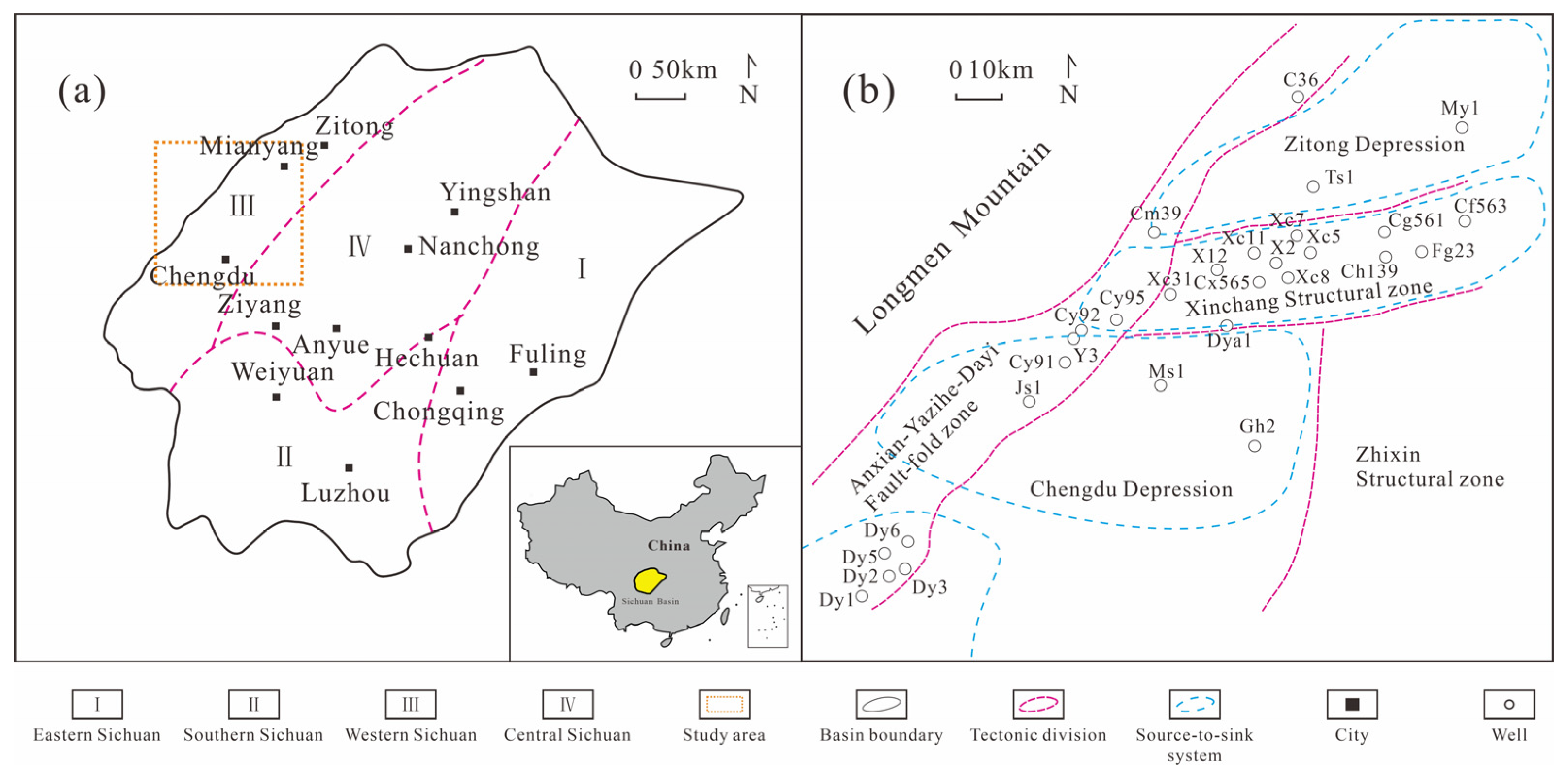
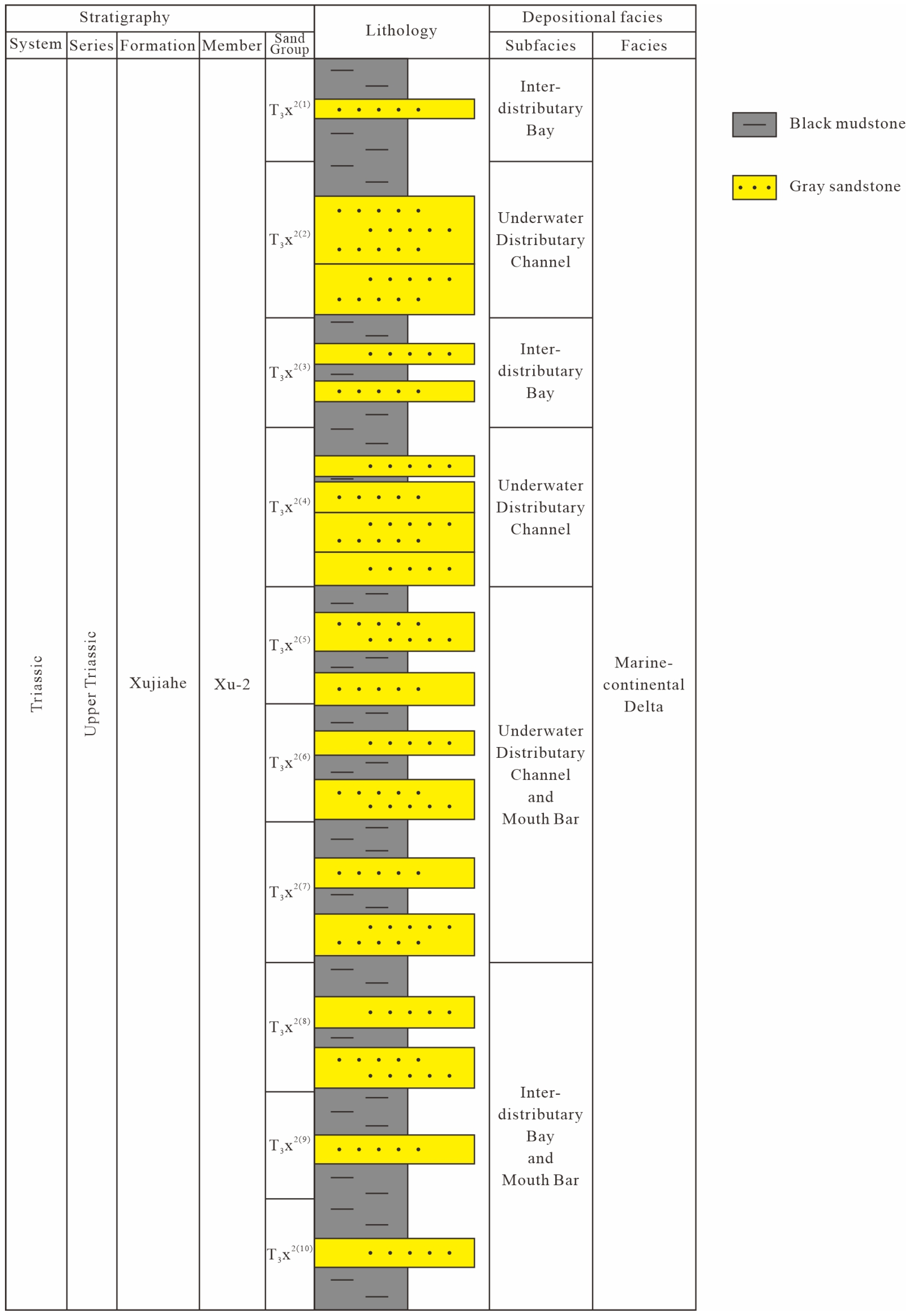
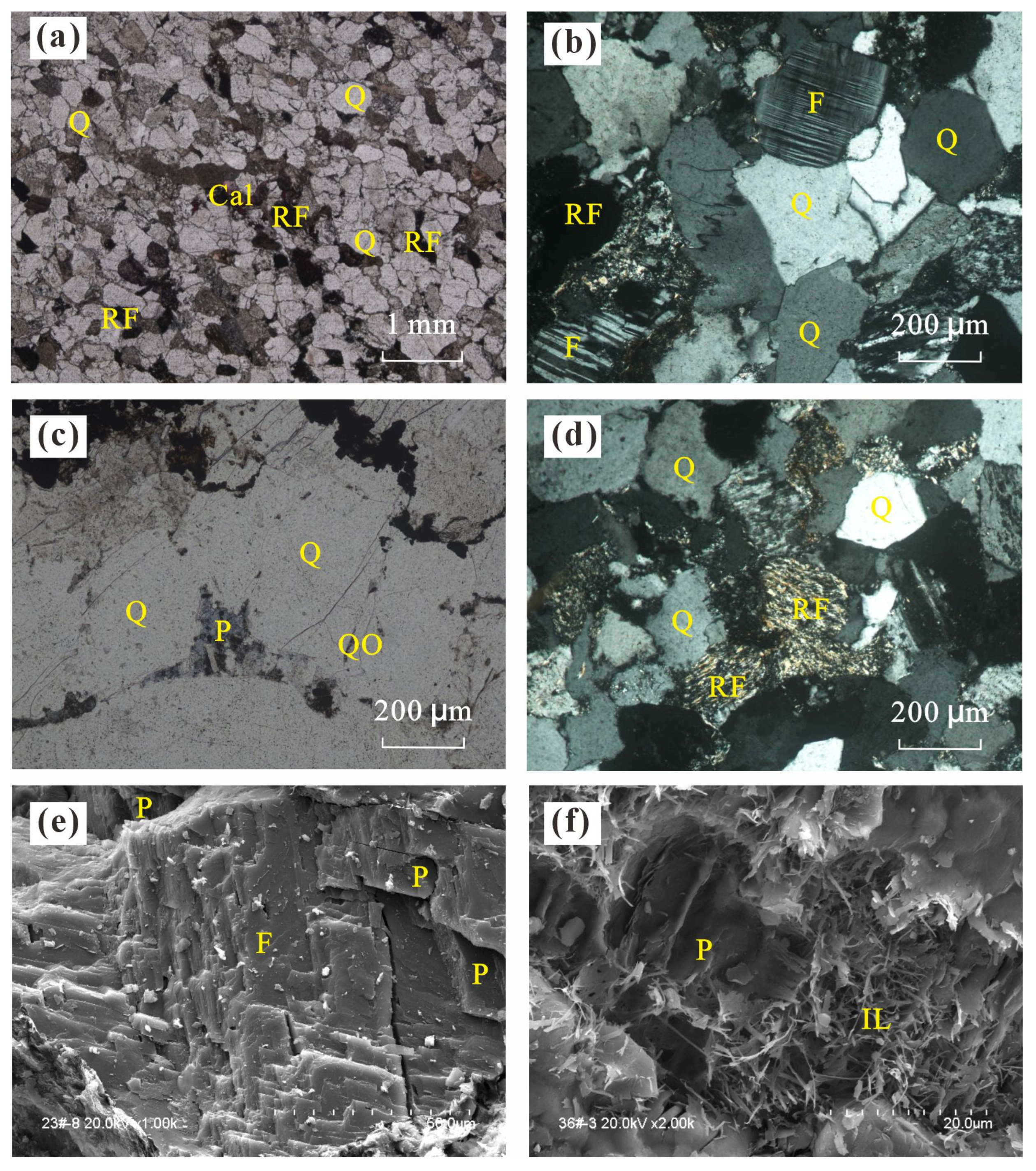

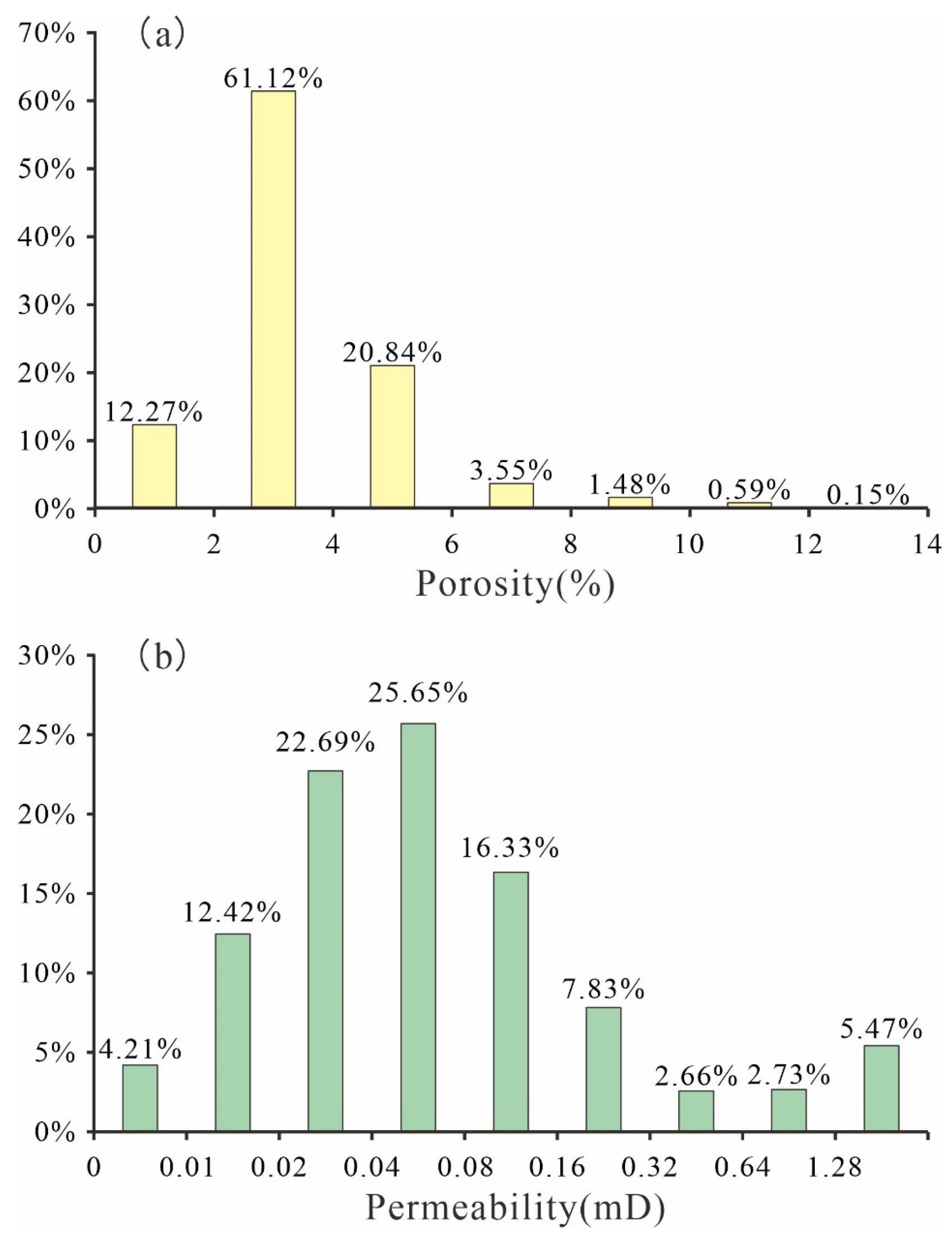
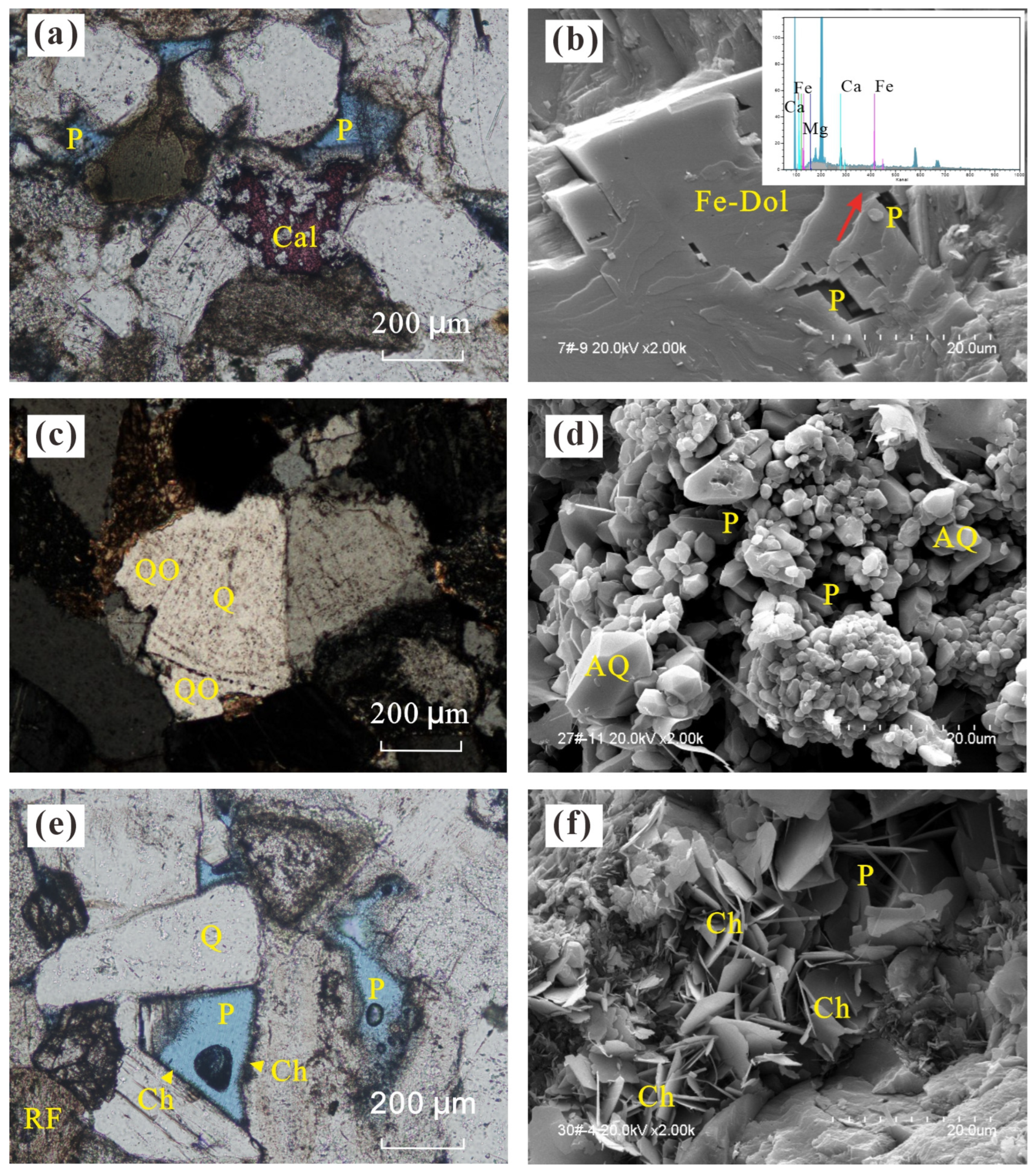

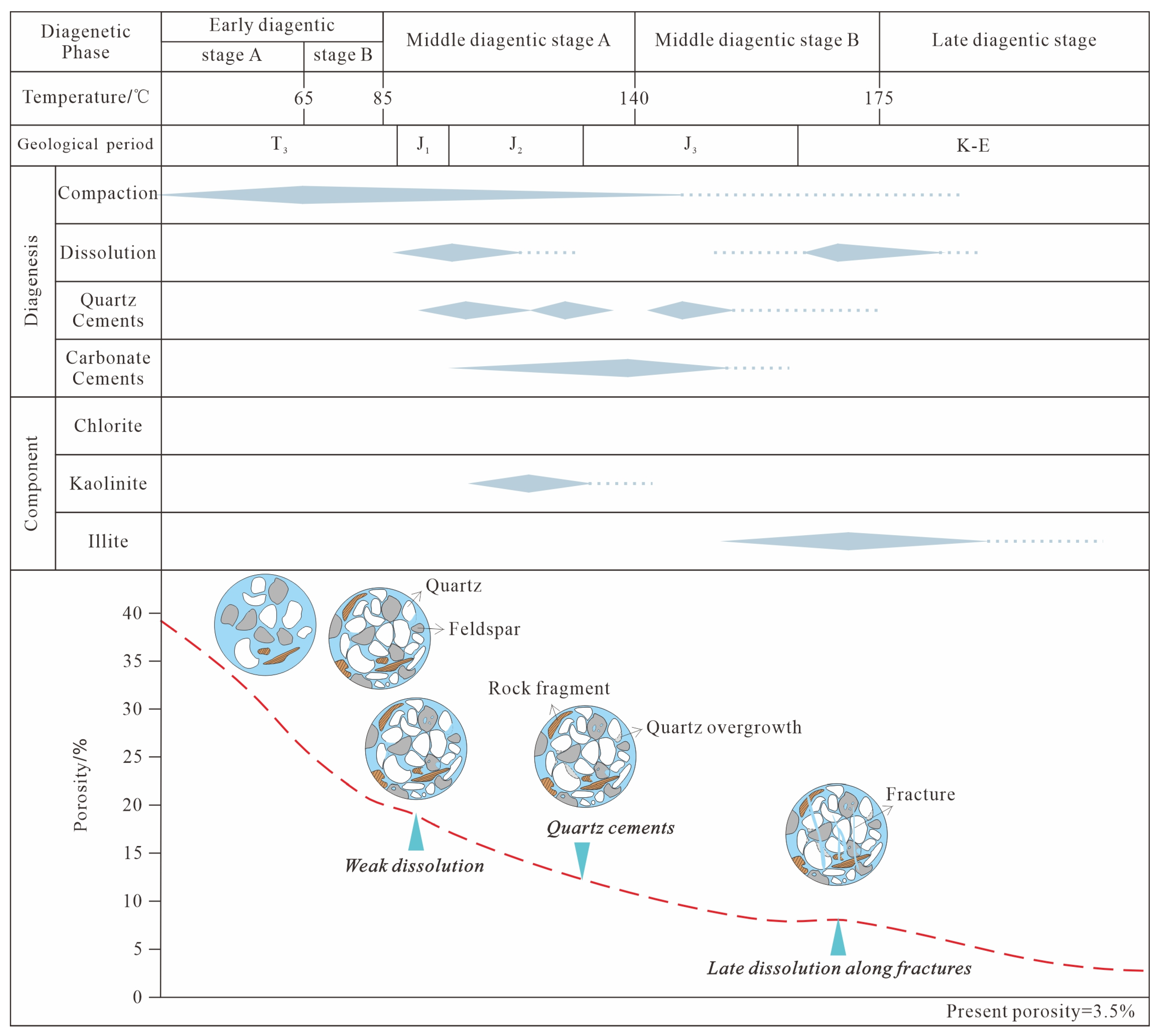
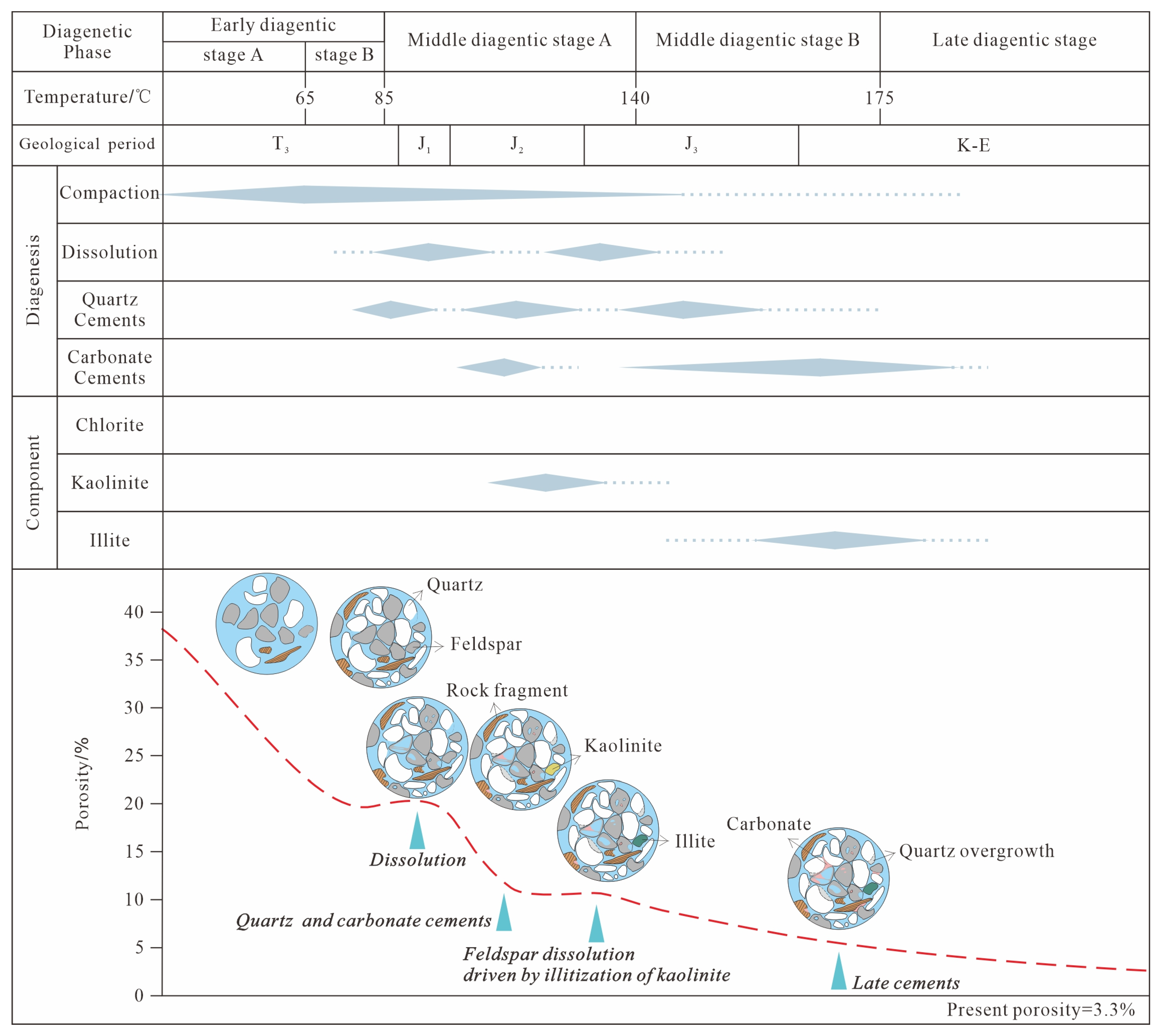


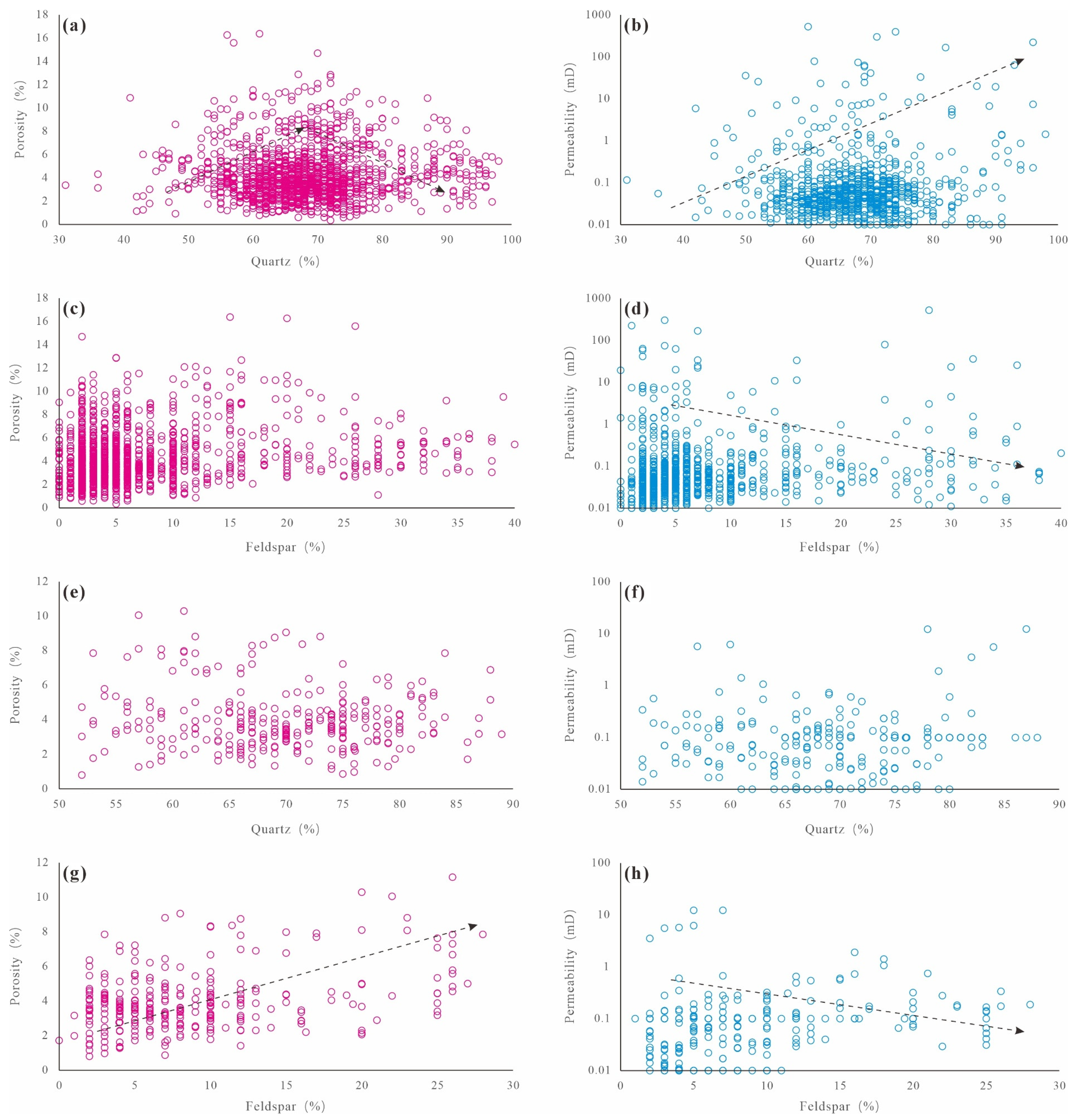
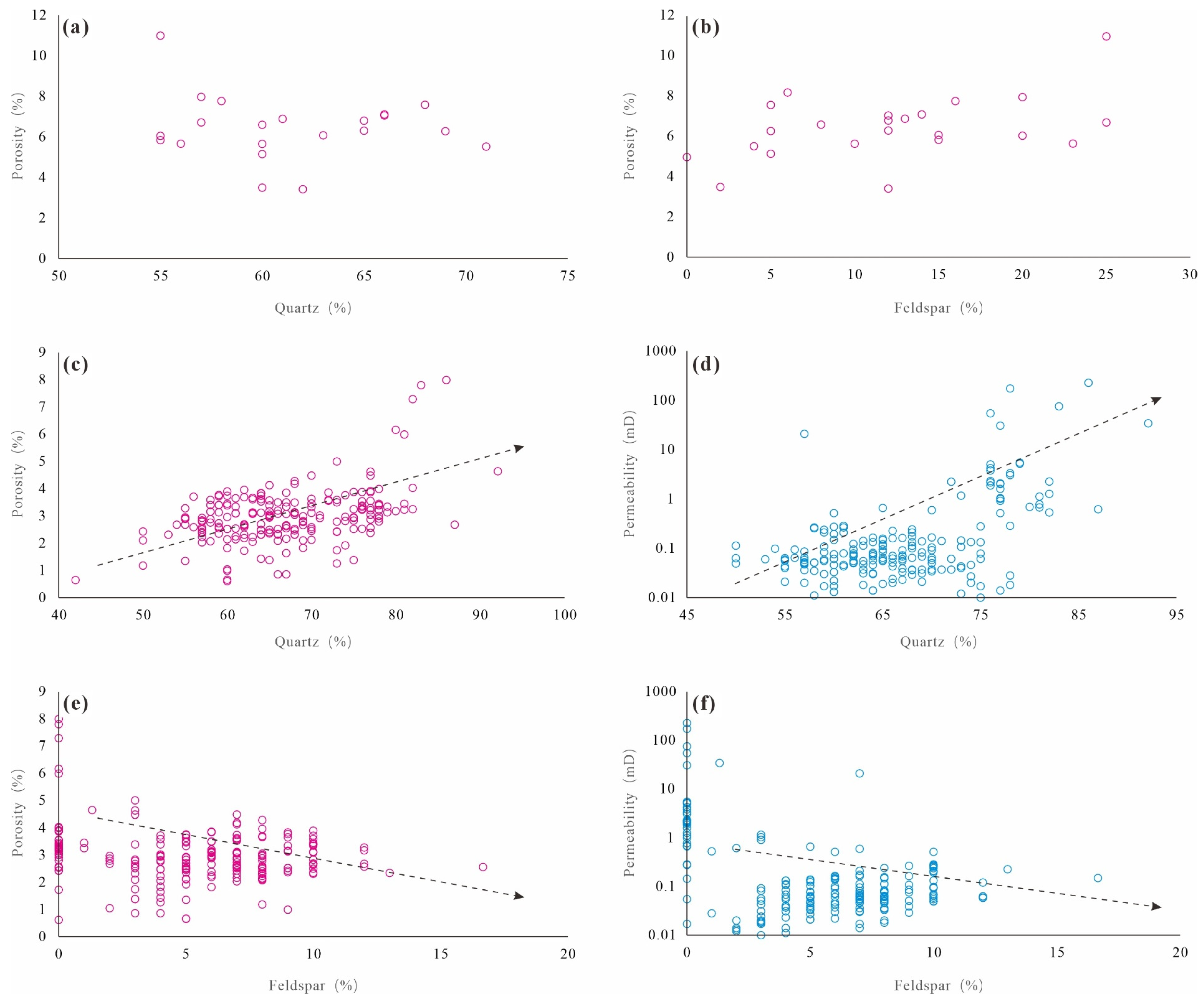
Disclaimer/Publisher’s Note: The statements, opinions and data contained in all publications are solely those of the individual author(s) and contributor(s) and not of MDPI and/or the editor(s). MDPI and/or the editor(s) disclaim responsibility for any injury to people or property resulting from any ideas, methods, instructions or products referred to in the content. |
© 2025 by the authors. Licensee MDPI, Basel, Switzerland. This article is an open access article distributed under the terms and conditions of the Creative Commons Attribution (CC BY) license (https://creativecommons.org/licenses/by/4.0/).
Share and Cite
Wu, D.; Yu, Y.; Lin, L.; Liu, S.; Li, B.; Ye, X. Study on Reservoir Characteristics, the Tightening Process and Reservoir Quality in Source-to-Sink Systems in the Xu-2 Member of the Xujiahe Formation in the Western Sichuan Basin, Western China. Minerals 2025, 15, 625. https://doi.org/10.3390/min15060625
Wu D, Yu Y, Lin L, Liu S, Li B, Ye X. Study on Reservoir Characteristics, the Tightening Process and Reservoir Quality in Source-to-Sink Systems in the Xu-2 Member of the Xujiahe Formation in the Western Sichuan Basin, Western China. Minerals. 2025; 15(6):625. https://doi.org/10.3390/min15060625
Chicago/Turabian StyleWu, Dong, Yu Yu, Liangbiao Lin, Sibing Liu, Binjiang Li, and Xiaolong Ye. 2025. "Study on Reservoir Characteristics, the Tightening Process and Reservoir Quality in Source-to-Sink Systems in the Xu-2 Member of the Xujiahe Formation in the Western Sichuan Basin, Western China" Minerals 15, no. 6: 625. https://doi.org/10.3390/min15060625
APA StyleWu, D., Yu, Y., Lin, L., Liu, S., Li, B., & Ye, X. (2025). Study on Reservoir Characteristics, the Tightening Process and Reservoir Quality in Source-to-Sink Systems in the Xu-2 Member of the Xujiahe Formation in the Western Sichuan Basin, Western China. Minerals, 15(6), 625. https://doi.org/10.3390/min15060625




